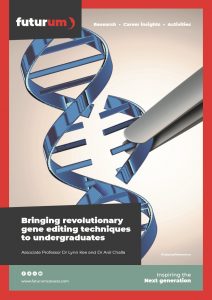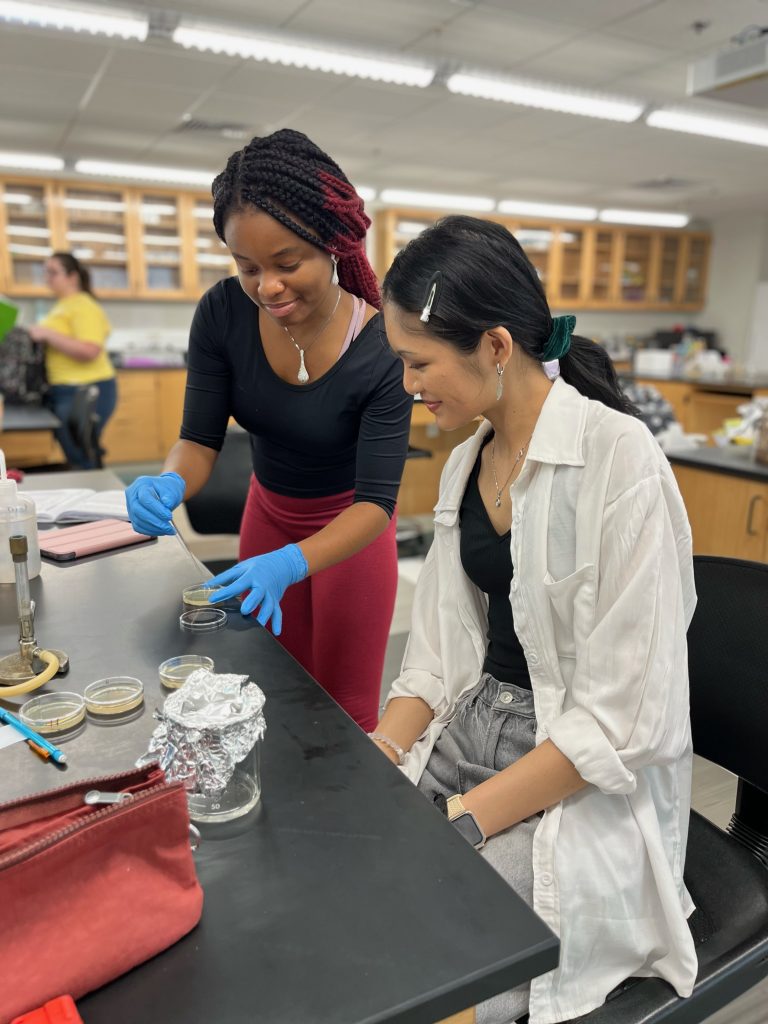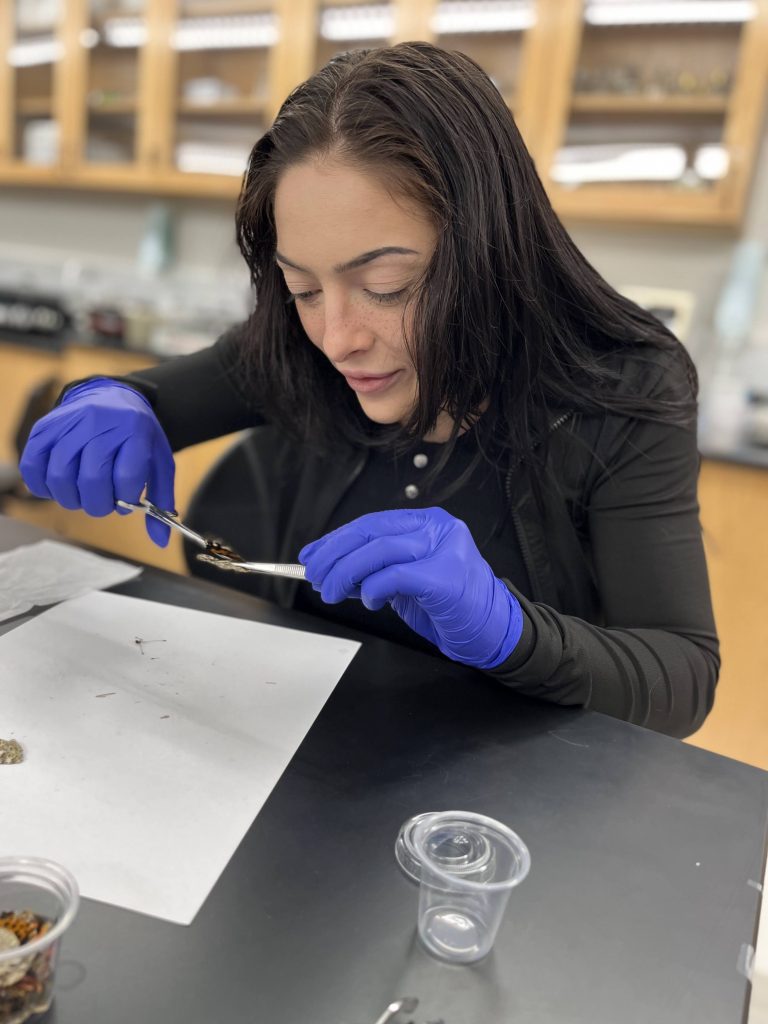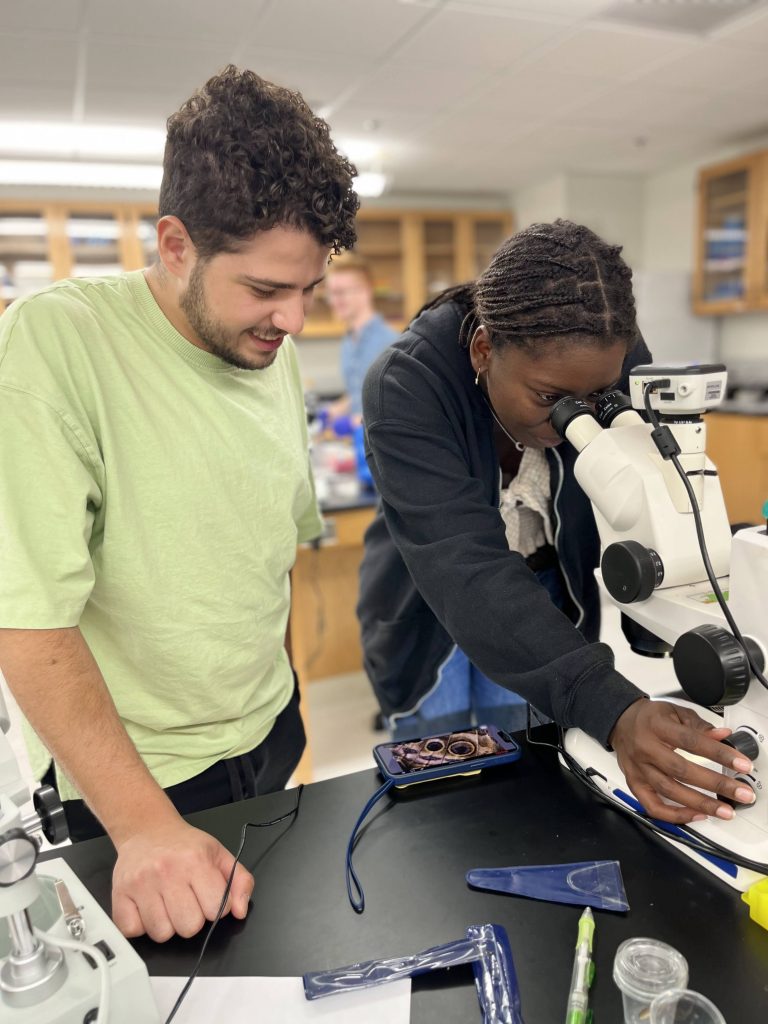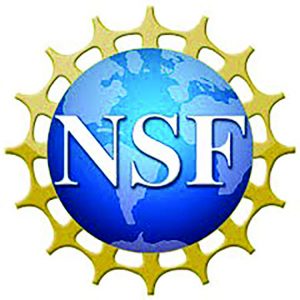Bringing revolutionary gene editing techniques to undergraduates
In recent years, the emergence of a new genetic modification technique called CRISPR-Cas9 has made gene editing a dramatically faster and easier process for scientists. As part of the CRISPR in the Classroom Network, Dr Anil Challa from the University of Alabama at Birmingham and Associate Professor Dr Lynn Kee from Stetson University, both in the US, are bringing CRISPR-Cas9 to the university classroom, teaching undergraduates how to use this important tool.
Talk like a molecular geneticist
CRISPR-Cas9 — a genetic modification technology that allows the precise editing of genes
DNA — a nucleic acid that acts as the self-replicating carrier of genetic information in almost all organisms
Gene editing — a type of genetic modification that typically involves a small, precise change to a living organism’s existing DNA
Genetic modification — a broad term that involves using laboratory-based technologies to alter the DNA of an organism
Genome — the complete set of genetic material present in a cell or organism
Genotype — the genetic makeup of an organism; the specific genes that an organism carries
In vitro — a laboratory process involving biological molecules or cells that takes place outside an organism, e.g., in a test tube or culture dish
In vivo — a laboratory process that takes place within a living organism
Polymerase chain reaction (PCR) — a technique for rapidly producing multiple copies of a specific segment of DNA
Phenotype — the observable characteristics of an organism, resulting from the interaction of its genotype with the environment
RNA — a nucleic acid that typically acts as the intermediary between the reading of genes in an organism’s DNA and their expression, via the creation of proteins
Gene editing is allowing scientists to learn more about how our genes work than ever before, and to find groundbreaking solutions to real-world problems. The emergence of CRISPR-Cas9 has made this process dramatically easier and more accessible. “The technical ease with which CRISPR-Cas9 experiments can be designed, assembled and tested makes it very exciting,” says Dr Anil Challa, from the University of Alabama at Birmingham’s College of Arts and Sciences. “Additionally, progress made in other areas of chemistry and molecular biology has accelerated the pace at which CRISPR-Cas9 tools are being improved and reimagined.” Associate Professor Lynn Kee, from Stetson University, agrees: “The ease with which CRISPR technologies are being programmed and deployed has allowed the tool to be implemented in arenas applicable across biology, medicine and wider society.”
Anil and Lynn are part of the CRISPR in the Classroom Network, which aims to develop a national community of biology educators and empower them to integrate CRISPRCas9 into their courses. They both run courses for undergraduates at their respective universities, where they give them direct experience in using the technology to modify organisms’ genomes.
How CRISPR-Cas9 works
CRISPR-Cas9 allows scientists to edit parts of an organism’s genome by precisely removing, adding or altering sections of its DNA. It has two core components. The first is an enzyme called Cas9, which acts as a pair of ‘molecular scissors’, cutting the DNA at a specific location. It is accompanied by a piece of guide RNA, which is tailored to complement the DNA sequence of interest, and guides the Cas9 enzyme to the right point to cut. “The tool adds or removes DNA by manipulating natural DNA repair mechanisms,” explains Lynn. Anil adds, “Because cells targeted by CRISPR-Cas-9 do not tolerate the double strand breaks (DSBs) it creates, they repair themselves using their own biochemical machinery.”
CRISPR technology is already changing lives. “The first human clinical trial using CRISPR technology for immunotherapy cancer treatment is underway,” says Lynn. “It involves removing patients’ immune cells, editing them in vitro using CRISPR to specifically attack cancer cells, and reinserting them into the patient.” Similar techniques are being used to treat blood disorders too. Clinical trials are also using in vivo approaches. For example, modified viruses are inserted into patients’ retinal cells, where they release CRISPR components that modify the gene that controls the genetic eye disorder Leber congenital amaurosis 10. “CRISPR is also penetrating our everyday lives in other ways,” says Lynn. “For instance, crops such as tomatoes and mushrooms are being modified to be bigger and to stay fresh for longer.”
In the undergraduate lab
“CRISPR-Cas9 technologies are becoming commonplace in both academic and industrial laboratories,” says Anil. “A working knowledge of the system is highly valuable to undergraduate students for their future careers.” The rapid pace of progress is exciting but also poses challenges for teaching students how to use the latest tools. “Course textbooks provide limited scope on the topic and do not reflect the most current advances, while most papers and reviews are too detailed and complicated for undergraduates to understand fully,” says Lynn. “This raises the need to develop effective educational practices and experiences framed around CRISPR technology.”
Alongside lessons on the fundamentals of molecular biology, direct exposure to CRISPR technologies in the lab is the most effective way of teaching students about these tools’ capabilities and how to harness them. “CRISPR technology can be used to apply biological principles, in particular to build understandings of how genotypes affect phenotypes – in other words, how genetic information leads to the creation and organisation of proteins, cells, tissues and whole organisms,” says Lynn. Students also learn key practical laboratory skills that are applicable across a range of disciplines. “Students learn that the scientific process is not linear, but made up of multiple progressive steps,” says Lynn. “Experiments may not work as planned and need repeating, so students learn perseverance and focus. Students also develop critical thinking skills, specifically how to interpret their data and form a conclusion from their results.”
Anil’s zebrafish lab
Researchers often use a ‘model organism’ for their studies – that is, a non-human organism that helps them understand key biological processes. In Anil’s lab, the model organism is the zebrafish. “The zebrafish is a powerful model organism, amenable to experimental studies and allowing us to learn more about vertebrate biology,” he says. “Students can study this model organism to gain familiarity with vertebrate embryonic development, genome analysis, genetic and molecular biological investigations, and connections between genotype and phenotype.”
A typical experiment to introduce undergraduates to CRISPR involves posing a question about a gene involved in the embryonic development, physiology or behaviour of the zebrafish. “After setting the question, students analyse the gene using bioinformatics tools, which then leads them to be able to design the CRISPR guide RNA,” says Anil. “They prepare this single guide RNA (sgRNA) to be specific to the sequence of interest, and then validate whether it works in vitro.” If it does, the next step is embryo injections for in vivo testing of what happens when the gene in question is ‘knocked out’. “Students have a go at making microinjections and, later, observe for phenotypes caused as a result of the loss of gene function,” says Anil. “Finally, they isolate the embryos with these phenotypes and perform PCR-based genotyping experiments to find out what genetic mutations have arisen due to CRISPR-Cas9 activity.”
This project has had successes beyond the classroom. “The big highlight has been the publication of a peer-reviewed journal article, including contributions from all students who participated in the research experience,” says Anil. “Several students have benefitted from this recognition in their later academic pursuits.”
Lynn’s butterfly lab
Lynn chose a less common model organism for her course: the painted lady butterfly. “We considered several commonly-used genetic model organisms, such as Drosophila fruit flies, C. elegans nematode worms and or Xenopus frogs,” she explains. “However, it’s not easy for students to deliver CRISPR into the eggs of these organisms, or to obtain sufficient eggs at all.” The embryos of C. elegans, for instance, are only 50 μm across – invisible to the naked eye. “While other instructors perform the delivery of CRISPR into model organism eggs on students’ behalf, I wanted my students to do the delivery through microinjection themselves,” says Lynn.
Reference
https://doi.org/10.33424/FUTURUM442
This led to the selection of painted lady butterflies, which lay hundreds of eggs, each about 1 mm in length. “Using a stereomicroscope, students can use a microinjection system to poke a hole into the butterfly egg and push in the CRISPR components,” says Lynn. “It’s a process that requires strong hand-eye coordination, but, with practice, students become better and more confident.”
And the experience has paid dividends. “The teamwork and class camaraderie has been amazing,” says Lynn. “Students have been able to successfully create the desired CRISPR change, and some were even successful in rearing a butterfly with a physical change due to the CRISPR targeting, such as an unusual wing colour. From this, students learn that the gene they are targeting with CRISPR is responsible for normal wing colour development.” Lynn also discusses the ethics involved in genetic manipulation with the class. “I showcase real-world CRISPR case studies, and we talk about the bioethical implications,” she says. “It’s important to me that the students are informed citizens of the world and can communicate about their work.”
CRISPR technology has huge potential to benefit society, and the CRISPR in the Classroom Network is ensuring that educators, including Anil and Lynn, are preparing the next generation of scientists to truly make the most of it. How could you be using CRISPRCas9 technology in your future career?
 Associate Professor Dr Lynn Kee
Associate Professor Dr Lynn Kee
Stetson University, DeLand, USA
CRISPR 360°: Design, Implementation and Evaluation of a CRISPR technology toolkit for Undergraduate Education (NSF Award Number 2044385)
Dr Anil Challa
College of Arts and Sciences, University of Alabama at Birmingham, USA
NSF Research Coordination Network-Undergraduate Biology Education: Bringing CRISPR-CAS9 Technologies to the Undergraduate Classroom: An Undergraduate Instructors’ Network, Award #2120417
Fields of research: Molecular genetics, molecular and cell biology
Research project: CRISPR in the Classroom Network: introducing undergraduate students to CRISPR-Cas9 technologies through hands-on laboratory experiments
Funder: US National Science Foundation (NSF)
About molecular genetics
Molecular genetics involves investigating how an organism’s DNA affects their phenotype, and how changing the sequence, structure or expression of the DNA leads to changes in an organism’s physiology, development or behaviour. Principally, this is achieved through using genetic manipulation techniques, such as CRISPR-Cas9, to genetically modify organisms. “I love how molecular genetics allows me to tinker, stay curious and keep exploring,” says Lynn. “I enjoy working with students to answer new questions and to teach them lab techniques.” Anil agrees about the excitement of crossing new frontiers. “Gaining new knowledge is one of the biggest rewards of pursuing research in molecular genetics,” he says.
CRISPR technologies are rapidly advancing the field of molecular genetics. “CRISPR is becoming a routine tool in molecular biology,” says Anil. “It is opening up new opportunities to address finer questions around cellular identity, genome accessibility and epigenetic modifications.” CRISPR modifies genes by disrupting them, so they cannot be expressed, or altering them, so that a different version of the gene is expressed.
Previous technologies were capable of doing similar tasks but with a lower level of precision and requiring more resources, time and experience. CRISPR’s reliability, universality and ease of use has opened up an endless array of possibilities. “CRISPR is also now being used in other ways,” says Lynn. “For example, it can rapidly diagnose viral infections, such as human papillomavirus (HPV), which can cause cancer, and Zika, a virus spread by mosquitoes. Other variants of CRISPR can do different things – for instance, CRISPRCas13 targets RNA, not DNA.”
Pathway from school to molecular genetics
• Anil recommends getting a good grounding in chemistry, mathematics and computational thinking at school and college.
• Both Anil and Lynn suggest taking university courses or modules in biochemistry, genetics, molecular biology and cell biology.
Explore careers in molecular genetics
• The University of Alabama at Birmingham, where Anil works, is home to the Center for Community Outreach Development, which offers high school students hands-on science experiences through classes and summer schools.
• Stetson University, where Lynn works, runs the Stetson Young Scholars programme, which runs weekend workshops, summer camps and more for middle and high school students.
• The University of Chicago’s Marine Biological Laboratory runs a residential High School Science Discovery Program, which includes a course on CRISPR-Cas9.
• The US National Science Foundation funds the Research Experiences for Undergraduates programme. For biological sciences.
• According to ZipRecruiter, the average salary for a molecular geneticist in the US is around $100,000 a year.
Meet Anil
Reading about the pursuit of scientific explorations through biographical and autobiographical works inspired me to become a scientist. I still read a lot today.
Good mentoring, peer interactions, and reading and discussing science all helped shape me as a scientist. These days, interactions with students drive me to continue improving.
Helping develop the ‘CRISPR in the Classroom’ college teacher network has been a career highlight for me. In addition, I’m proud to have developed a successful research experience for first-year undergraduates, to introduce them to CRISPR technology.
I aim to build on these successes in the future. I want to continue to contribute to rich experiences for high school and college students.
Anil’s top tips
1. Read at least one biography or autobiography about a key person in the history of science. It can open your eyes to the background of where we are now.
2. Keep a childlike perspective of the world when asking questions. It is always these fundamental questions that are actively pursued in research.
3. Research is a team endeavour. Find ways to experience the value of teamwork – it will help you in the future.
Meet Lynn
I grew up in Yokohama, Japan, and spent a lot of my childhood playing outside. I immersed myself in imaginative play and exploring nature, and I think this was the foundation for my curiosity about how the world works.
I sought out lab-based research experience as an undergraduate student. It was wonderful and had a profound effect on me, leading me to go on to study for a PhD in cell and developmental biology. My graduate supervisor, Dr Kristen Verhey, mentored me in how to think critically about scientific questions and ways to address them.
I remember the first time I ‘stained’ cells with dyes to label their proteins and DNA as a graduate student. I used a fluorescent microscope to see these components literally light up in red, green and blue. This is one of my most memorable experiences – peeking inside the inner workings of a cell, the basic building block of life.
A few years ago, I was awarded a grant to develop and implement CRISPR technology for undergraduate students. This allowed me to buy equipment for my classes and hire students to work with me. I am very proud of the students I have mentored, who have gone on to pursue their dreams.
I am proud to have found a balance between family and work. I had my first child when I first started working at Stetson University as a professor, and I now have three beautiful children. My husband is also a professor at a nearby university. Every day, we dedicate ourselves to our family and our professions.
Lynn’s top tips
1. Find what excites you and pursue it. I thought CRISPR technology was interesting but had never been trained in it, so I read about it, figured out how to do it, and am now teaching it to my students and other faculty.
2. Seek out mentors. I was lucky enough to work in the lab of an inspirational professor, Dr Roland Kwok, during my undergraduate degree, where I learnt many lab techniques. Before then, I didn’t really understand biology at the fundamental level and how to apply it.
3. Community matters. Find peers and mentors who can be a support system for you, and that you can talk to about all things science, opportunities, and ways to overcome challenges.
4. It’s okay to make mistakes. I have made many, but I have learnt from these failures and found a way forward.
Do you have a question for Anil or Lynn?
Write it in the comments box below and Anil or Lynn will get back to you. (Remember, researchers are very busy people, so you may have to wait a few days.)

